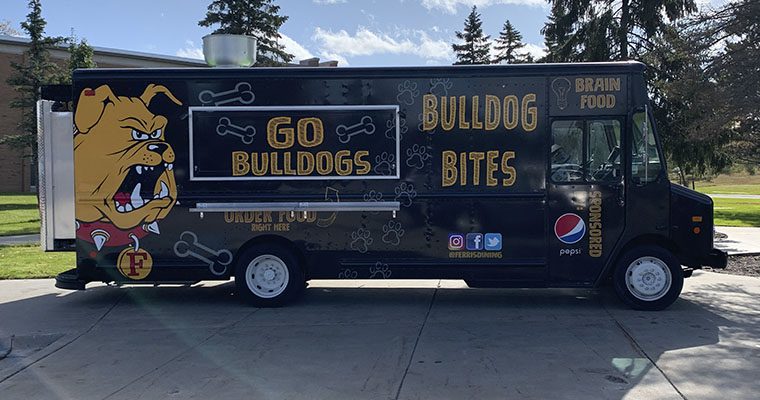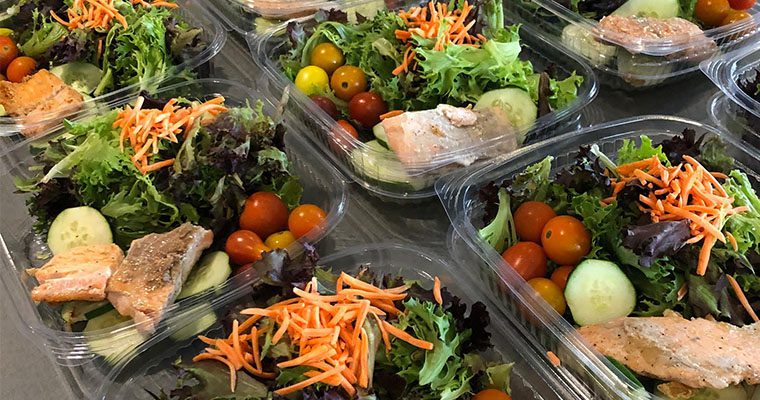You’ve heard of The Great Depression. You lived through The Great Recession. For college and university dining, COVID-19 marks the start of The Great Adaptation. September brought campuses a lot of mouths to feed, along with many changes, including menu choices, safety practices, staffing and more.
Campus dining directors at the University of Notre Dame, Ferris State University and University of Michigan agree that the fall term demonstrates how student dining operations must be agile and able to convert their business model in a crisis.
This was especially evident at Notre Dame in South Bend, Indiana, where in-person classes paused after a virus outbreak. Senior Director of Campus Dining Chris Abayasinghe calls the transformation “The Great Adaptation.”
“We still housed students on campus during that time, so my team was activated as if the school year was still functioning,” he says, but it also came with a lot of changes. His team had to address traffic flow into the dining hall for pickup-only meals, provide packaged hot meal options, satisfy vegetarian and vegan appetites, employ GrubHub online order technology for takeout, and even stand by commitments to use environmentally conscious disposable packaging.
Hand sanitizing stations? A must.
Self-service? Gone.
The salad bar? Replaced by premade salads.
Hot meals? Yes, mostly for takeout.
Students can sit at a safe social distance in the dining halls at Ferris State in Big Rapids, Michigan. At U-M in Ann Arbor and Notre Dame, dining hall seating is off-limits. Notre Dame students eat under tents or at other designated areas, in their dorm rooms, or at campus restaurants where there’s limited seating.
Safety, customer experience and technology
To make it work, Abayasinghe’s team put its focus on safety and customer experience. “Our students’ ID cards have chips embedded in them for contactless transactions,” he says. “And with social media, it’s possible for students to Tik Tok their dining experience so we can learn opportunities to improve in real time.”

Contactless card-swipe technology also is in use at U-M, where there are seven open-access dining halls doing takeout only. Social distancing means only 100 people can line up inside a building that normally holds 1,100. “No one has ever designed a dining hall for a situation like this,” says Steve Giardini, U-M’s Senior Associate Director of Residential Dining. “We’re focused on getting students in and out of there in five minutes.” Serving about 6,500 students and 12,000 meals a day also takes communication. Giardini’s team encourages students to eat at non-peak times to limit crowds.
Among the things U-M is doing differently this year is setting up additional locations designed to allow meal plan holders quick and easy access to food while decreasing the amount of students in the dining halls. The menu also is slimmed down—about half of the normal options—with each dining hall offering the same menu to prevent students from shopping around. “We’re making sure we have something for every dietary preference, and we’re hyper focused on making sure we have special diets and allergies covered.”
The staffing battle and beyond
Scaled-down service and takeout-only is actually very labor intensive. That’s because self-serve stations, including beverages, require staffing. It comes at a time when most schools are working with reduced staff.
That’s the case at Ferris, where Director of Dining Services Scott Rossen says his reduced staff has really stepped up to package food, operate a full-service taco bar and sanitize every table and chair after use.
As for food, student favorites like General Tso’s chicken, veggie lasagna, macaroni and cheese with meatloaf are among a dozen options ready to heat and go. There’s even a salad robotics vending machine. “We’re seeing success from the grab-and-go,” Rossen says. “We purchased a lot of reusable to-go containers and gave them to every student coming onto campus—that’s helped eliminate some of the disposable waste.”
Where takeout packaging is in use there has been lots of trash talk.
“I’ve had more conversations about trash in the last three weeks than ever,” Giardini says. China and silverware have been replaced by disposables no longer put into dumpsters by dining services workers. It has created a behavior change for campuses to address with waste haulers and recycling handlers.
Another change has been what Abayasinghe likens to a hospital-based approach to food delivery. At Notre Dame and Ferris, students exposed to the virus are living in quarantine, and their meals must be safely delivered. Food carts and contact-free have been employed, but the real challenge is good service. “It all comes back to data,” Abayasinghe says. “It’s getting information specifically tied to diners and their dietary needs so our teams can fill orders.”
Looking into the future
Preparation, a focus on safety and technology are things all three universities cite as positives that will last beyond the COVID-19 era. The pandemic put a lot of off-premise technology—contactless payment, mobile ordering and curbside pickup—into high gear.
All three also praise the flexibility of their teams. U-M’s Giardini sums it up best: “The biggest silver lining out of this is the ability of our team to react and pivot and continue to do so … there has been a lot of positive growth.”
The Great Adaptation indeed.











